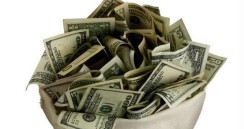 Ivan Garcia, 6 April 2015 — Without being an expert in economic matters or the Wall Street currency market, Erasmo likes to trust his instincts. For fourteen years he has been engaged in buying and selling dollars and euros.
Ivan Garcia, 6 April 2015 — Without being an expert in economic matters or the Wall Street currency market, Erasmo likes to trust his instincts. For fourteen years he has been engaged in buying and selling dollars and euros.
Also convertible pesos. In the doorway of his house, within walking distance of a state-run currency exchange (CADECA), he offers his services in a lowered voice to the people standing in line to buy or sell CUCs.
“Privately buying or selling currency is illegal in Cuba. The police have already sent me a warning letter and I have paid two fines of 1,200 Cuban pesos (about 50 dollars) for transacting currency exchanges.”
His modus operandi is simple. Like the state, he buys the CUC for 24 pesos and resells it for 25. But for international currencies, such as the dollar or the euro, he pays a better price than the state banks.
“I’m starting to see Cuban residents of the U.S. who are visiting the island, wanting to exchange five or six thousand dollars. The state pays 0.87 CUC for every dollar. I offer 0.94 CUC for bills up to twenty dollars. On large bills of 50 and 100 dollars I pay 0.95. And I have clients who I will buy from at one-for-one,” said Erasmo.
The olive-green regime has mounted exchange operations remote from the framework of world prices. Cuba, despite its third-world economy and infrastructure, by official decree pegs its currency to the U.S. dollar by its own free will.
When Fidel Castro came to power in 1959, the Cuban peso was valued on par with the dollar. But economic planning and nationalization of businesses dramatically reduced the production of goods and wealth.
The State used artificial exchange rates and prohibited the possession of hard currency. Cuban law carried punishments of up to five years’ imprisonment for persons possessing foreign currency or engaging in currency exchange.
In street slang, “jinetear” [jockeying]—a word that used to be used for prostitution—was applied to people prowling hotels and resorts to buy dollars, paying a better price than that offered at the official exchange.
“During the mid-80s, I went every day to La Rampa, in Vedado, to “jockey” greenbacks. The government bought dollars one-for-one. We jineteros paid four or five pesos. We invested the profits in buying clothes and food from foreign students or residents who bought them at stores selling for U.S. dollars, to which we Cubans were prohibited access,” says Juan Carlos, who has been conducting clandestine foreign exchange for more than thirty years.
In 1993, with the legalization of the U.S. dollar, hyperinflation soared in the country. After the fall of the Berlin Wall and the demise of the USSR, Cuba plunged into an era of poverty.
Oxen replaced tractors, and one hot meal a day was a family event. Food prices soared and the dollar reached a value of 150 Cuban pesos.
By the late 90s, the storm subsided and the US dollar stabilized at 24 pesos. Throughout the island hundreds of CADECAS opened, allowing people to buy or sell dollars.
In 2005, following a banking scandal in the Swiss bank UBS, which was fined one hundred million dollars by OFAC, in order to replace old dollars in a five-billion-dollar account in the name of the Cuban regime, Fidel Castro decreed a tax of 20% on the currency of the United States, his archenemy.
Illegal moneychangers like Erasmo began to sell the dollar at a better price. “The thousands of Cuban doctors and professionals working in Ecuador, Venezuela, and South Africa bought them one by one. They invested those dollars to buy duty-free goods, mobile phones, or plasma televisions which they then resold at three times their purchase price.”
In 2011, General Raúl Castro fixed the exchange rate for the dollar at 87 cents. “On the black market we’re always two or three steps ahead when it comes to the monetary policies of the government. It’s simple: we’re on the street and are guided by supply and demand. The state only knows how to govern with monopolies and decrees, not with the market,” Erasmo says.
That diluted exchange rate hurt more than 700,000 Cubans living in the U.S. who visited their homeland in 2014. “They’ve built a casino. Between one thing and another, I spent nearly seven thousand dollars. Their assessment siphoned off $910. They’re bandits,” says Santiago, a Havanan who lives in New York.
Augusto, an economist, suggests to people that they save whatever foreign exchange they get in dollars. “It is advisable, especially right now with the fall of the euro and the resurgence of the dollar. According to my calculations, when the currency in Cuba is unified, the dollar will shoot up. It won’t reach 120 pesos as in the 90s, but it will trade at three times what the banks pay, because inflation can become dangerous in the future, for the lack of takeoff in production of goods and food. If the government wants to increase tourism from the U.S. it should eliminate the arbitrary 13% tax.”
Since the summer of 2013, the military autocracy has declared its intention to unify the currency. Periodic rumors cause Cubans-without-milk-for-coffee to cover their backs for a possible devaluation of the convertible peso, changing their savings into dollars.
The Castro regime has ensured that, for the moment, the savings of citizens will not be affected. But the instinct of guys like Erasmo says that the money saved under the mattress is best held in dollars. Just in case.
